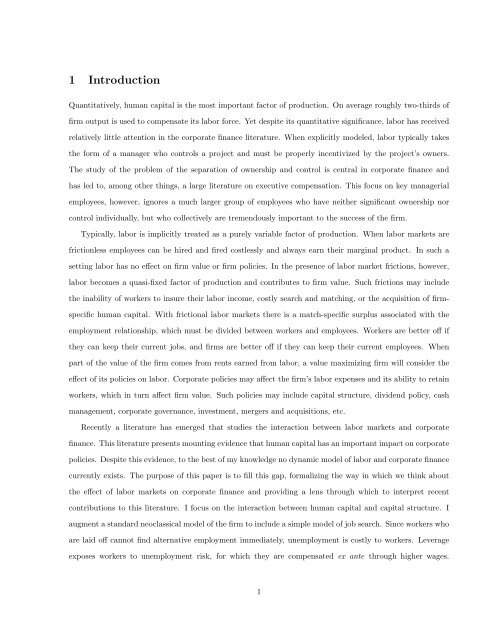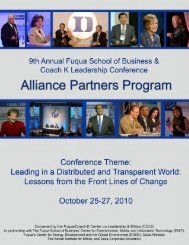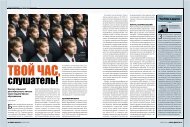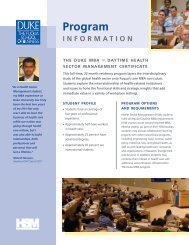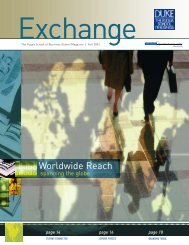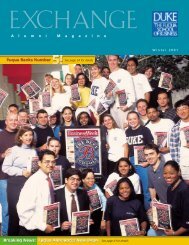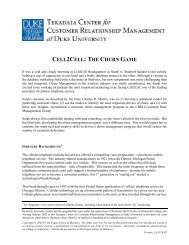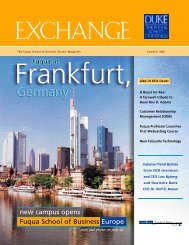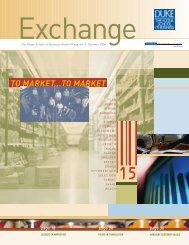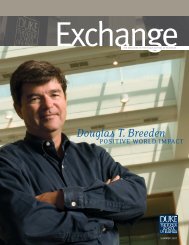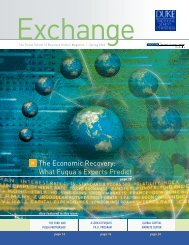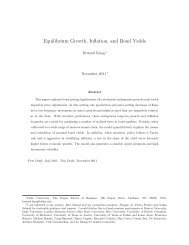A Structural Model of Human Capital and Leverage - Duke ...
A Structural Model of Human Capital and Leverage - Duke ...
A Structural Model of Human Capital and Leverage - Duke ...
Create successful ePaper yourself
Turn your PDF publications into a flip-book with our unique Google optimized e-Paper software.
1 Introduction<br />
Quantitatively, human capital is the most important factor <strong>of</strong> production. On average roughly two-thirds <strong>of</strong><br />
firm output is used to compensate its labor force. Yet despite its quantitative significance, labor has received<br />
relatively little attention in the corporate finance literature. When explicitly modeled, labor typically takes<br />
the form <strong>of</strong> a manager who controls a project <strong>and</strong> must be properly incentivized by the project’s owners.<br />
The study <strong>of</strong> the problem <strong>of</strong> the separation <strong>of</strong> ownership <strong>and</strong> control is central in corporate finance <strong>and</strong><br />
has led to, among other things, a large literature on executive compensation. This focus on key managerial<br />
employees, however, ignores a much larger group <strong>of</strong> employees who have neither significant ownership nor<br />
control individually, but who collectively are tremendously important to the success <strong>of</strong> the firm.<br />
Typically, labor is implicitly treated as a purely variable factor <strong>of</strong> production. When labor markets are<br />
frictionless employees can be hired <strong>and</strong> fired costlessly <strong>and</strong> always earn their marginal product. In such a<br />
setting labor has no effect on firm value or firm policies. In the presence <strong>of</strong> labor market frictions, however,<br />
labor becomes a quasi-fixed factor <strong>of</strong> production <strong>and</strong> contributes to firm value. Such frictions may include<br />
the inability <strong>of</strong> workers to insure their labor income, costly search <strong>and</strong> matching, or the acquisition <strong>of</strong> firm-<br />
specific human capital. With frictional labor markets there is a match-specific surplus associated with the<br />
employment relationship, which must be divided between workers <strong>and</strong> employees. Workers are better <strong>of</strong>f if<br />
they can keep their current jobs, <strong>and</strong> firms are better <strong>of</strong>f if they can keep their current employees. When<br />
part <strong>of</strong> the value <strong>of</strong> the firm comes from rents earned from labor, a value maximizing firm will consider the<br />
effect <strong>of</strong> its policies on labor. Corporate policies may affect the firm’s labor expenses <strong>and</strong> its ability to retain<br />
workers, which in turn affect firm value. Such policies may include capital structure, dividend policy, cash<br />
management, corporate governance, investment, mergers <strong>and</strong> acquisitions, etc.<br />
Recently a literature has emerged that studies the interaction between labor markets <strong>and</strong> corporate<br />
finance. This literature presents mounting evidence that human capital has an important impact on corporate<br />
policies. Despite this evidence, to the best <strong>of</strong> my knowledge no dynamic model <strong>of</strong> labor <strong>and</strong> corporate finance<br />
currently exists. The purpose <strong>of</strong> this paper is to fill this gap, formalizing the way in which we think about<br />
the effect <strong>of</strong> labor markets on corporate finance <strong>and</strong> providing a lens through which to interpret recent<br />
contributions to this literature. I focus on the interaction between human capital <strong>and</strong> capital structure. I<br />
augment a st<strong>and</strong>ard neoclassical model <strong>of</strong> the firm to include a simple model <strong>of</strong> job search. Since workers who<br />
are laid <strong>of</strong>f cannot find alternative employment immediately, unemployment is costly to workers. <strong>Leverage</strong><br />
exposes workers to unemployment risk, for which they are compensated ex ante through higher wages.<br />
1


